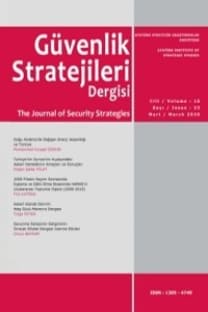Dünya Ordularında Yeniden Yapılanmanın Kaynakları Üzerine Bir İnceleme
Askerî güç, daima ulusal gücün önemli belirleyici unsurlarından biri olmuştur. Bu nedenle birbirlerine karşı güçlü olmak isteyen devletler askerî güçlerini sürekli geliştirme ve büyütme çabası içinde olmuşlardır. Bu çabada devletlerin tehdit algılamaları etkili olmaktadır. Bununla birlikte devletlerin tehdidi algılamaları zaman içinde değişmiş ve değişen algıları ile birlikte askerî gücü geliştirme çabası ekonomik, teknolojik, siyasal ve sosyal faktörlerce sürekli etkilenmiştir. Özellikle teknolojik gelişmelerin askerî sistemler üzerinde önemli etkisinden bahsedilebilir. Sonuçta muharebe alanına farklı boyutlar dâhil olarak, alanın sürekli değişmesine ve büyümesine neden olmuştur. Bu çalışmada son yüzyılda dünyada yaşanan savunma planlama yaklaşımlarındaki değişimler ile bu değişimlerde etkili olan faktörler ele alınmakta; özellikle tehdit algılamaları ile teknolojik gelişmelerin askerî sistemler üzerine etkileri incelenerek orduların ne tür değişimler yaşadıkları, ayrıca son dönemde yaşanan değişimlerin gelecekte olabilecek yansımaları üzerine odaklanılmaktadır.Anahtar Kelimeler:Askerî Güç, Teknolojik Değişim, Yeniden Yapılanma.
Anahtar Kelimeler:
Askerî Güç, Teknolojik Değişim, Yeniden Yapılanma
-
Military power has always been one of the important determinants of national power. Therefore, states, which want to be strong against each other, have been in continuous effort to develop and enhance their military forces. Threat perception of the states was effective in this effort. However, threat perception of the states has changed over time and the effort to develop military power has been constantly affected by economic, technological, political and social factors. Especially the influence of technological developments on the military systems can be mentioned. As a result, different dimensions have been added to the battlefield and the field has continuously changed and grown. In this study, the changes on the defense planning approaches in the last century and the factors, which have affected these changes, are discussed. The effects of threat perception and technological developments on military systems and on the army changes are analyzed. In addition, possible future implications of the recent changes are discussed. Key Restructuring. Words: Military Power, Technological Change
Keywords:
-,
___
- Altmann, J., Military Nanotechnology Potential applications and preventive arms control, New York: Routledge, 2006.
- Bertaud, J., “Napoleon's Officers”, Past & Present, No. 112, 1986, s. 91
- Blaine, T.W., “Global Climate Change”, Ohio State University Fact Sheet, http://ohioline.osu.edu/cd-fact/0186.html, Erişim Tarihi:
- Bostrom, N., “Astronomical Waste: The Opportunity Cost of Delayed Technological Development”, Utilitas, 15, 2003, s. 308-314. doi:1017/S0953820800004076. Britannica Online http://www.britannica.com/EBchecked/topic/1350805/history-of- Encyclopedia, technology.htm, Erişim Tarihi: 14.02.2013.
- Büyükanıt, Yaşar, “New Approaches to Security and the Transformation of the Turkish Military”, 2010, http://www.eurasia critic.com/category/author/yasar-buyukanit, Erişim Tarihi: 05.12.2011.
- Çelik, Ş., Stuxnet Saldırısı ve ABD’nin Siber Savaş Stratejisi: Uluslararası Hukukta Kuvvet Kullanmaktan Kaçınma İlkesi Çerçevesinde Bir Değerlendirme, Dokuz Eylül Üniversitesi Hukuk Fakültesi Dergisi, Cilt: 15, Sayı: 1, 2013, s.137-175 Çevikalp, http://aksiyon.com.tr/aksiyon/haber-15437-36-2020den-once-aya- yolculuk-hayal.html, Sayı: 700/05-05-2008, Erişim Tarihi: 12.12.2013.
- Chase, K., Firearms: A Global History to 1700, Cambridge University Press. 2003. 2020’den History of Technology, M., Önce Ay’a Yolculuk Hayal,
- Cusumano, E. “Outsourcing Military Training: The Role of Security Networks in Foreign Military Assistance” Annual Meeting of the International Studies Association Annual Conference, Montreal, Quebec, Canada, March 2011, p. 16.
- Davis, P.K., “Planning under Uncertainty Then and Now: Paradigms Lost and Paradigms Emerging”, New Challenges for Defense Planning: Rethinking How Much is Enough, Ed. P.K. Davis, (RAND), 1994, s. 15-57.
- Defense News, Agence France-Presse, Chinese Military Build-Up No Threat, Official, 2011, http://www.defensenews.com/story.php?i= 6688765, Erişim Tarihi: 12.12.2011.
- Dias, D., Partnering with Private Networks: The Dod Needs a Reserve Cyber Corps, Yayımlanmamış Yüksek Lisans Tezi, U.S. Army War College, Carlisle, PA, 2008.
- Dünya Bankası Veri Tabanı, http://data.worldbank.org/indicator/ MS.MIL.XPND.GD.ZS, Erişim Tarihi: 12.08.2014
- Edmunds, T. “A New Security Environment? The Evolution of Military Roles in Post-Cold War Europe”, Edmunds T. and M. Malesic (Eds.) Defence Transformation in Europe: Evolving Military Roles, IOS Press: 2005, s. 9-18.
- FlorCruz, J., China’s Military Modernization a Cause for Concern?, June 17, 2011, CNN, http://articles.cnn.com/2011-06-17/world/ china.military.modernization_1_aircraft-carrier-military-modernization -chen-bingde?_s=PM:WORLD, 2011, Erişim Tarihi: 12.12.2011.
- Gates, R., M., Secretary of Defense, Remarks by Secretary Gates at the United States Air Force Academy, 2011, http://www.defense.gov
- /transcripts/transcript.aspx?transcriptid=4779, 2013.
- Georgia Update, Russian Invasion of Georgia, Russian Cyberwar on Georgia, 2008, http://georgiaupdate.gov.ge/doc/10006922/CYBER
- WAR%20fd_2_.pdf, Erişim Tarihi: 29.12.2011.
- Greenemeier, L., Drone Wars: 9/11 Inspired Advances in Robotic Combat, ScientificAmerican.com, 2011, http://www.livescience.com/ 15908-drone-wars-september-11-anniversary.html, 2011. Erişim Tarihi: Erişim Tarihi:
- Gregory, G., “Threats and Threat Perceptions in the Persian Gulf Region, Journal Compilation”, Middle East Policy Council, 2007, s. 119
- Gupta, S., Clements, B., Bhattacharya, R., and Chakravarti S. “The Elusive Peace Dividend”, Finance & Development, A quarterly magazine pubs/ft/fandd/2002/12/ gupta.htm, Erişim Tarihi: 09.05.2012. Haacke,
- Isom, R.G., “Contractors in Support of Joint Vision 2020 Focused
- Logistics: Perspectives and Possibilities”, Strategy Research Project, April 2002.
- Jablonsky, D., Army Transformation: A Tale of Two Doctrines, Parameters, Autumn 2001, s. 43-62.
- Korkmazyürek, H. ve Varoğlu, K., “The Defense Planning for Turkey and the Lessons Learned for Developing Corporate Strategies”, International Journal of Business, Management and Economics, 2, 7, 2006, s. 13-28.
- Korkmazyürek, H., Stratejik Savunma Yönetimi Ders Notları, Kara Harp Okulu Savunma Bilimleri Enstitüsü, 2011.
- Mahnken, T.G., “Weapons: The Growth & Spread of the Precision- Strike Regime”, American Academy of Arts & Sciences, 2011, 140, 3, s. 45-57.
- Maier C.S., The Phases of the Cold War, 1945-1990. Princeton: Markus Weiner, 1996. http://www.historylearningsite.co.uk/
- ISSN: 1305-4740
- Yayın Aralığı: Yılda 3 Sayı
- Başlangıç: 2005
- Yayıncı: Millî Savunma Üniversitesi Atatürk Stratejik Araştırmalar ve Lisansüstü Eğitim Enstitüsü
Sayıdaki Diğer Makaleler
Yetenek Temelli Stratejik Yönetim Anlayışının ABD Silahlı Kuvvetlerinin Teşkilat Yapısına Etkisi
Rumeli Müfettişliği Döneminde (1902-1908) Makedonya’da Yunan Komitecileri ve Osmanlı Devleti
Bilimsel Araştırma Yöntemlerinin İstihbarat Analizinde Kullanılması
Rumeli müfettişliği döneminde (1902 -1908 makedonya'da yunan komitecileri ve Osmanlı devleti
Dünya Ordularında Yeniden Yapılanmanın Kaynakları Üzerine Bir İnceleme
